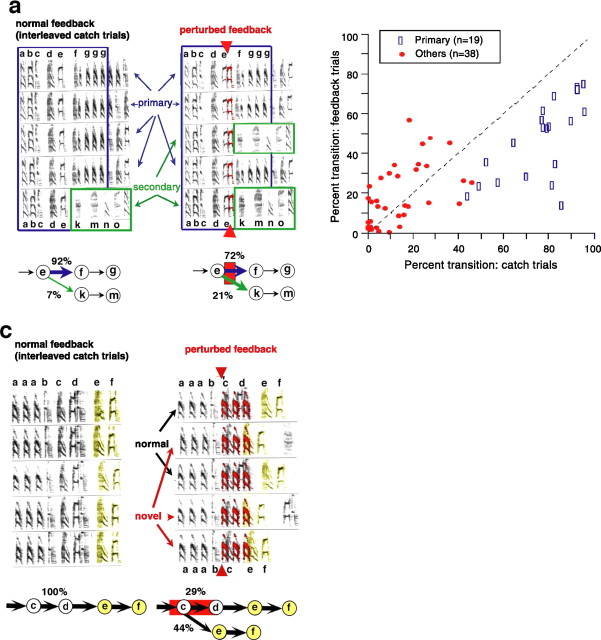Figure 3.
Perturbation of auditory feedback alters syllable sequencing. a, Example illustrating the effect of feedback perturbation on syllable transition probabilities. The left column illustrates song structure under normal feedback conditions on catch trials. Five representative spectrograms are shown vertically aligned to illustrate the regularity of normal song structure surrounding a targeted syllable (“e”) of the bird's song. As indicated in the transition diagram at the bottom, the primary transition from syllable “e” was to the sequence “fgg… ” (92% of the time). An additional, secondary transition from the syllable “e” to the sequence “kmn… ” occurred only rarely (7% of the time, interruptions accounted for the additional 1%). The right column illustrates song structure during randomly interleaved trials when feedback was altered by superposition of a delayed version of the syllable “e.” As indicated at the bottom, the bird produced the same two transitions, but with different probabilities relative to catch trials. The probability of the primary transition (“e” → “fgg”) was significantly lower (72 vs 92%), with a corresponding increase in the probability of the secondary transition (“e” → “kmn”; 21 vs 7%; p < 0.01). b, Summary of changes to transition probabilities for 19 experiments in which AAF significantly affected syllable sequencing. The probability of primary transitions (blue rectangles) was decreased under conditions of perturbed feedback. Other transitions at branch points (red circles) could be increased or decreased. The number of other transitions exceeds the number of primary transitions because there were often multiple alternatives to the primary transition at a given branch point in song. The frequency of song interruptions for catch and feedback trials is not plotted. c, Example illustrating a completely novel sequencing of syllables elicited by a more dramatic alteration of auditory feedback. Here, syllable “c” of the bird's song was followed 100% of the time by the sequence “def” under normal feedback conditions (catch trials; left column). On randomly interleaved trials, feedback was altered by playing back three repetitions of the syllable “a” (right column). On 29% of these altered feedback trials, the bird continued to produce the normal primary transition from syllable “c” to syllable “d” (black arrows, normal). However, on 44% of the trials, the bird produced a completely novel transition from syllable “c” directly to syllable “e” (red arrows, novel; for the remaining 27% of altered feedback trials, songs were interrupted). In each of these instances of novel sequencing, the syllable “d” was omitted and the pattern “ef” was produced earlier than normally. The syllables “ef” are colored yellow to highlight this dramatic disruption of the normal sequencing and timing of syllable production.

